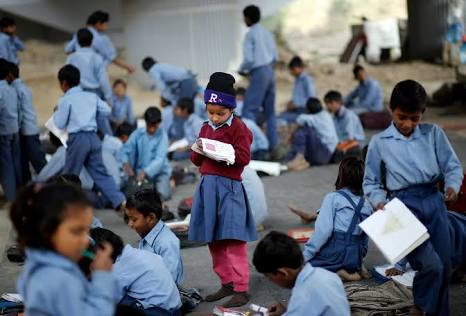This article has been written by Shyantika Khan and Sreejita Makhal.
Table of Contents
Introduction
Educating a child from grassroots level is an influential element that could open doors to ideas and creativity. Utmost care has to be taken for their holistic development so that they could be a contributing factor to the nation’s growth. Right to education is an indispensable right irrespective of distinctions on any ground. This paper explores to find out the answers to the reasons for infringement of the right to education. It centralizes its ideas on developing countries and their approach to handling difficulties regarding children’s educational rights and reflects the Indian jurisprudence for educational rights. Certain declarations and legislation are enacted to protect their educational rights and help them grow. The United Nations and its several other bodies have taken up the goal to eradicate poverty and provide elementary education to all children.
Educating a child is watering a sapling to grow into a tree,
full of fruits of knowledge and strength.
-Anonymous
Right to education is a fundamental right and no racial barriers, gender or sex shall stand as a hurdle to seek education. At a tender age, underprivileged children are forced into child labour to support their families when they are supposed to go to school and get educated. In many countries, girls are stopped from going to schools. For example, in Afghanistan, girls are married before attaining 18 finally leading them to be school dropouts. UNESCO Institute of Statistics held out that around a figure of 263 million children dropped out of school wherein 61 million children were from primary schools. There are millions of children all over the world who are deprived of basic educational rights. In Unni Krishnan v. State of AP and Ors, the right to education was classified into the group of fundamental rights.
Child’s right to education – international outline
The Right to Education is advanced, recognized and shielded at all levels from local to global. Education has a crucial role not only in emancipating women, shielding children from exploitative and perilous work, advancing human rights and promoting democracy but also protecting our environment and controlling population growth.
Numerous international protocols, various writings and reports by United Nations (UN) bodies highlight the significance of the basic right to education. The Right to Education is a crucial human right. Education is an exceptional apparatus of entitlement. It is fundamental for the advancement and assurance of all the human rights. Accomplishing the right to essential education, as a principle human right, is one of the greatest advancement challenges faced globally.
Conventions and Declarations
The universal community reaffirmed the Right to Education at the World Education Forum in 2000. As a matter of fact, the Right to Education is codified and assorted in the Universal Declaration of Human Rights (UDHR), Convention on the Rights of the Child (CRC), the Convention on the Elimination of All Forms of Discrimination against Women (CEDAW), International Covenant on Economic, Social and Cultural Rights (ICESCR), and International Covenant on Civil and Political Rights (ICCPR). The United Nations Educational, Scientific and Cultural Organization have put Right to Education at the front line of its activities. The Education for All (EFA) is its primary agenda. The Right to Education is a fundamental piece of UNESCO’s constitutional ordinance.
International Covenant on Economic, Social and Cultural Rights- Education Provisions
At the international level, the ICESCR has given two articles to the Right to Education, to be specific, Articles 13 and Article 14. Article 13(1) of the ICESCR says that parties concur that all education, regardless of whether private or public, formal or non-formal, will be coordinated towards the points and goals recognized under Article13 (1). Article 13(2) of the ICESCR, states full acknowledgement of this right conceives necessary and free essential education for all, availability to auxiliary general education with a dynamic presentation of free education and the liberty given to guardians to choose schools for their children. The structure and substance of education, including educational curricula and teaching techniques, must be adequate to students as well as guardians.
Right to Primary and Secondary Education
Article 13(2) (a) of the ICESCR states essential education will be mandatory and allowed to all. Essential education incorporates the 4 A’s – Availability, Accessibility, Acceptability and Adaptability, which must be followed at all levels. The idea of this necessity is unequivocal. The right is explicitly planned to guarantee the accessibility of essential primary or basic education without any charge to anyone. Expenses forced by the legislature, the local authorities or the school, and other direct expenses, establish disincentives to the enjoyment of such right and may endanger its acknowledgement.
Article 13(2)(b) of ICESCR applies to secondary education in its various structures, subsequently perceiving that secondary education requires adaptable educational programs or curricula and changed conveyance frameworks to react to the necessities of students in various social settings. Article 13(2) (b) states that secondary education will be made commonly accessible and available to all by proper method, and specifically by the dynamic presentation of free education.
Educational rights jurisprudence in India
In India, the legal executive has demonstrated its profound concern for giving free and mandatory education to all children beneath the age of 14 years. The right to free primary education has now been proclaimed as a fundamental right by the Indian Supreme Court. The hypothesis of the compatible idea of rights proclaimed in Part III and Part IV and the amicable translation of these rights have been the establishment for the acknowledgement of primary education as one of the fundamental rights in India.
Case Reference
The Supreme Court of India in the Bandhua Mukti Morcha case held that the right to education is verifiable in and streams from the right to life ensured by Article 21. The right to education has been treated as one of divine significance in the life of an individual throughout the world. The issue of the extension and degree of right to education came up before the Apex Court in Mohini Jain case. This case tended to the charging of capitation expenses by professional colleges. The Court held that the charging of capitation expenses was illicit.
Taking a gander at the interdependence of the rights ensured in Part III and Part IV of the Indian Constitution; the Court held that the Directive Principles, which are fundamental in the administration of the nation, can’t be separated from the central rights ensured under Part III of our constitution. Subsequently, the Supreme Court decided to raise the right to education as a major aspect of crucial rights and made it legally enforceable.
Legal instruments protecting educational rights in India
Constitutional and fundamental rights
Article 21A of Indian Constitution
86th Amendment in the Constitution leads to inserting of Article 21A, a new addition to the right to life that is enshrined as a fundamental right. It states that free, compulsory education between 6-14 years of age. ‘Compulsory education’ throws a commitment on the Government and authorities to guarantee affirmation, participation and consummation of rudimentary education. The Supreme Court held that if any child deprived of educational rights is deprived of liberty rights and the right to freedom of expression.
Article 45 of the Indian Constitution
The State shall work towards the goal for free and compulsory education until attaining 14 years of age. It aims at reducing the illiteracy level in India.
Right to Education Act, 2009
Objective: Providing free and compulsory education to children within the age group of 6-14.
Reservation Criteria: The act strives all Indian private schools to reserve 25% of their seats for children
- No donations for getting admitted to a school for basic education.
- No interview required to get through and access to primary education
- Prohibition of caste based or economic status reservation by schools.
- Special training is mentioned in the Act for school dropouts.
Conclusion
Education not only empowers a brain but it leads to the formation of future leaders. It could remove two major problems in the world- Poverty and Social inequality. It is a state obligation to provide elementary education to children. To remove the biggest challenge of child labour and promoting education is a major task the Government of any nation has to look into and address the issue. Many children have potential yet they could not seek proper education in life. Making laws and leaving it in documents doesn’t educate a nation but proper implementation is necessary. After years of enactment of the Right to Education Act, it is not properly implemented. The government must work towards removing hurdles in accessing education and stop parents from dropping their children from schools forcefully. No gender, caste or financial discrimination would thus, be proportional to empowered minds and an educated nation.
LawSikho has created a telegram group for exchanging legal knowledge, referrals and various opportunities. You can click on this link and join:
 Serato DJ Crack 2025Serato DJ PRO Crack
Serato DJ Crack 2025Serato DJ PRO Crack











 Allow notifications
Allow notifications



